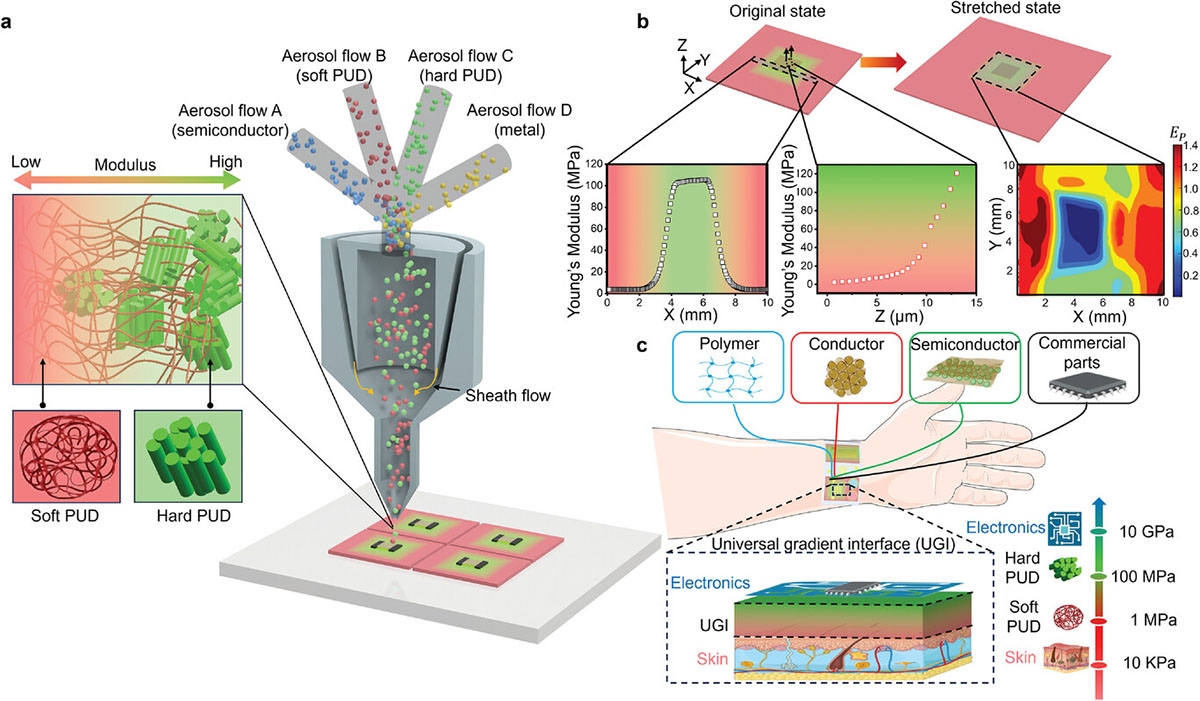Research Progress
Microscopic material gradients enable strain-proof flexible bioelectronics
发布时间: 2025-02-27 17:25 点击:687
| Electronic devices that monitor vital signs often fail when stretched or twisted, limiting their use in medical monitoring. Rigid circuit boards crack, flexible materials degrade, and hybrid solutions break at material interfaces. A new printing technique from University of Notre Dame and UCLA researchers solves this through microscopically graduated materials that maintain electrical performance even when stretched to nearly double their size. |
| The findings have been published in Advanced Materials ("A Printed Microscopic Universal Gradient Interface for Super Stretchable Strain-Insensitive Bioelectronics"). |
| This fundamental challenge has restricted medical device development for decades. Early attempts at flexible electronics focused on inherently stretchable materials, but these suffered from poor conductivity and rapidly deteriorated. Alternative approaches used serpentine patterns to make rigid materials more flexible yet produced bulky devices that lost contact with skin during movement. Engineers tried embedding stiff components within soft materials, but these failed where rigid and flexible sections met, creating weak points that broke under strain. |
| Biological systems already demonstrate an elegant solution: graduated transitions between materials of different rigidity, like the interface between tendons and bones. This smooth progression prevents stress concentration at any single point. However, recreating such precise material gradients at microscopic scales has proven technologically elusive - until now. |
| The research team developed what they term a "universal gradient interface" (UGI) using aerosol-based multi-material printing. This technique converts materials into fine mists that can be precisely layered and mixed. By controlling the ratio of soft and rigid materials during deposition, they create transitions in mechanical properties at submicron scales - far finer than previous methods could achieve. |
 |
| Stretchable devices enabled by universal gradient interfaces (UGIs) printed using aerosol-based multi-materials printing (AMMP). a) Scheme for one-step AMMP to print both UGI and functional devices. b) Schematic illustration of the original and stretched states of a 3D gradient UGI. Young’s modulus distributions of the UGI and the maximum principal Lagrange strain map of the 3D UGI under 100% bi-axial stretch ratio. c) Schematic illustration of the wide range of materials that can be integrated with the UGI. (Image: REPRINTED FROM DOI:10.1002/adma.202414203, CC BY) (click on image to enlarge) |
| Initial tests demonstrated the UGI's capabilities through simple conductive traces made from various materials including gold nanoparticles, silver nanowires, and specialized conducting polymers. When stretched to double their original length, these circuits maintained stable electrical performance with resistance changes below 4.2%. Conventional flexible electronics typically fail completely under such strain. |
| The team then fabricated more complex devices, including light sensors that maintained consistent function even when stretched 25%. They created an array of nine photodetectors on an inflatable surface that continued working as the surface changed shape. This demonstrates the potential for electronics that conform to complex three-dimensional geometries while remaining fully functional. |
| Building on these results, they developed an integrated health monitoring patch combining multiple sensor types. Temperature sensors track body heat with high precision, while strain sensors detect pulse waves from blood flow, and optical sensors measure blood oxygen levels. Unlike conventional wearable devices, these sensors maintain accurate readings during body movement and deformation. |
| The printing process offers several key advantages beyond flexibility. The graduated material interface eliminates stress concentrations that typically cause device failure. The manufacturing approach requires fewer steps than existing methods for flexible electronics. Most importantly, the resulting devices achieve exceptional stretchability without sacrificing electrical performance. |
| The technology's versatility extends beyond health monitoring. The ability to create reliable electronic devices that flex and stretch could enable advances in artificial skin for robotics, adaptive prosthetics, and conformable displays. The printing technique works with a broad range of materials, suggesting applications across multiple fields. |
| The researchers demonstrated potential for commercial scaling through parallel printing with multiple nozzles. However, several challenges remain before widespread adoption becomes feasible. The long-term durability of these devices needs further testing, particularly under repeated stretching cycles. Manufacturing costs must decrease to compete with existing technologies. The integration of more complex electronic components, like microprocessors, requires additional development. |
| Despite these hurdles, this advance addresses a critical limitation in flexible electronics. By solving the fundamental challenge of connecting rigid electronic components to soft, moving surfaces, the technology establishes a new approach for creating wearable and implantable devices that maintain reliable operation during natural body movement. |
| The key innovation lies in mimicking nature's solution to connecting materials with different mechanical properties. Through precise control of material transitions at microscopic scales, the researchers have created electronic devices that achieve both flexibility and stability - a combination that could transform medical monitoring, human-machine interfaces, and countless other applications requiring electronics that move with the human body. |
Address: C508 Dingxin Building, Jilin University, 2699 Qianjin Street, Changchun 130012, P. R. China
Copyright © 2025 International Society of Bionic Engineering All Rights Reserved
吉ICP备11002416号-1
Copyright © 2025 International Society of Bionic Engineering All Rights Reserved
吉ICP备11002416号-1









